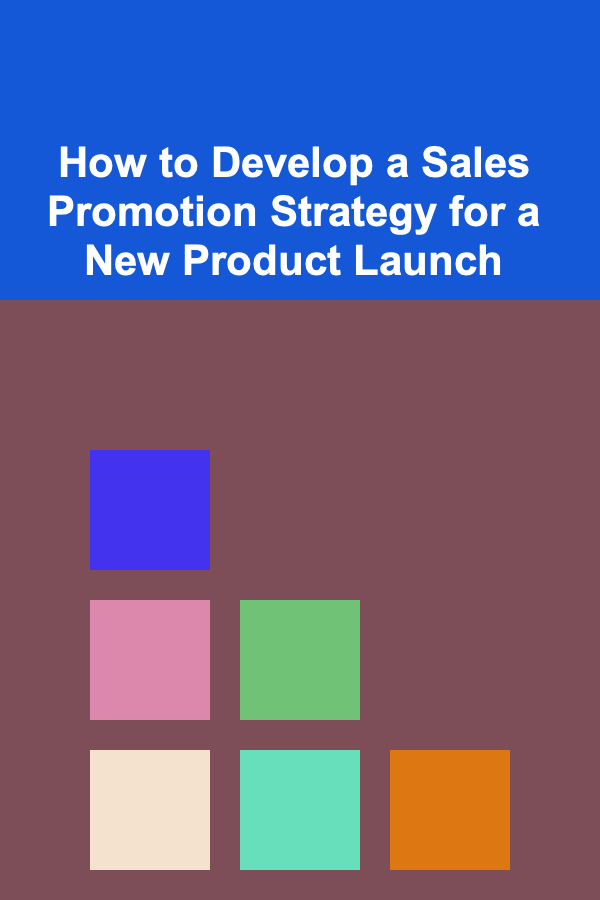
How to Develop a Sales Promotion Strategy for a New Product Launch
ebook include PDF & Audio bundle (Micro Guide)
$12.99$8.99
Limited Time Offer! Order within the next:

Launching a new product into the market is a significant event for any business, whether you're a startup or a well-established corporation. The success of a product launch is often tied directly to the strategy used to promote it. A well-thought-out sales promotion strategy can drive immediate interest, boost initial sales, and build long-term brand loyalty. This article will walk you through the essential steps and considerations for developing an effective sales promotion strategy for a new product launch.
Understanding the Importance of Sales Promotion
Sales promotion is any initiative designed to increase the demand for a product or service. It can take many forms, such as discounts, contests, samples, giveaways, and loyalty programs. For a new product launch, an effective sales promotion strategy can:
- Generate Awareness: Introducing a new product to the market often involves educating consumers about its existence and unique selling points. A solid sales promotion can attract attention and create a buzz.
- Drive Immediate Sales: A limited-time discount or offer can encourage customers to make a purchase sooner rather than later.
- Stimulate Trial: Free samples, demos, or introductory offers can reduce the perceived risk for first-time buyers and encourage them to try the product.
- Build Brand Loyalty: Sales promotions that offer rewards, loyalty points, or follow-up discounts can foster repeat purchases and long-term relationships with customers.
- Gather Valuable Data: Promotions can be a great tool for collecting consumer data, feedback, and preferences, which can guide future marketing efforts.
In the case of a new product launch, a targeted and well-planned sales promotion strategy can help solidify your market presence and set the stage for long-term success.
Step 1: Define Clear Objectives for the Promotion
Before diving into the specifics of your sales promotion strategy, it's essential to clearly define your objectives. Having well-defined goals ensures that your promotional efforts are focused, measurable, and aligned with your broader business strategy. Here are some common objectives for new product launch promotions:
1.1 Increase Brand Awareness
For a new product, the primary objective is often to make your target audience aware of its existence. If your brand is unknown or the product is highly innovative, awareness is the first step in your promotional strategy. To achieve this, you can use promotions like free samples, introductory offers, or even social media contests to spread the word.
1.2 Boost Initial Sales
Promotions that offer discounts or limited-time deals are effective at driving immediate sales. When introducing a new product, customers may hesitate to purchase it until they feel it offers value. Offering a time-limited discount, for instance, can create urgency and compel customers to act quickly.
1.3 Build Customer Loyalty
Sales promotions are an excellent opportunity to build a base of repeat customers. You can incentivize first-time buyers to return by offering loyalty rewards or follow-up discounts. Additionally, a customer who is satisfied with their initial purchase may be more likely to spread positive word-of-mouth and refer others.
1.4 Collect Consumer Data
Promotions such as surveys or sign-ups can help you collect valuable customer data, including preferences, behavior, and demographics. Understanding your customers' purchasing habits can guide your future product development and marketing efforts.
Once you've identified your objectives, ensure that they are specific, measurable, achievable, relevant, and time-bound (SMART). These objectives will guide your decisions on the type of promotion, timing, and target audience.
Step 2: Identify Your Target Audience
Understanding who your target audience is critical to the success of your promotion strategy. You need to know who you're trying to reach and what motivates them to make a purchase. Factors to consider when defining your target audience include:
- Demographics: Age, gender, income level, education, and geographic location.
- Psychographics: Lifestyle, interests, values, and purchasing behaviors.
- Customer Needs: What problems does your product solve, and how does it meet the needs of your target market?
- Buying Habits: What motivates your audience to make a purchase? Do they prefer discounts, premium features, or value-added bonuses?
For example, if you're launching a high-end tech gadget, your target audience might be tech-savvy professionals aged 25-45 with disposable income. If you're launching a health-conscious snack, your target market may be health-conscious individuals or those following specific dietary needs.
Understanding your target audience will help you tailor your promotional efforts and ensure that they resonate with the right people.
Step 3: Choose the Right Type of Sales Promotion
There are several types of sales promotions, each serving different objectives and target audiences. Selecting the right promotion type depends on your goals, budget, and customer preferences. Below are some of the most popular types of promotions for a new product launch:
3.1 Discounts and Coupons
Offering discounts is one of the most common sales promotion tactics. These promotions can be applied in many ways:
- Percentage-off discounts: A discount based on a percentage of the price, such as 20% off.
- Fixed-amount discounts: A set amount off the regular price, like $10 off the product price.
- Buy one, get one free: A popular promotion that can attract customers looking for added value.
Coupons, whether physical or digital, can help track which customers are using the promotions and can be linked to future sales.
3.2 Free Samples or Trials
Free samples or trial periods can reduce the perceived risk associated with a new product. This allows customers to try the product before committing to a full purchase. Sampling is particularly effective for food products, beauty products, and software.
3.3 Limited-Time Offers
Creating a sense of urgency with limited-time offers can compel customers to purchase your new product sooner. Time-sensitive promotions like flash sales or countdown deals (e.g., "48 hours only!") can drive excitement and motivate consumers to act quickly.
3.4 Contests and Sweepstakes
Contests and sweepstakes are engaging promotional strategies that can generate buzz and attract attention. These types of promotions often involve entry requirements like purchasing the product, signing up for a newsletter, or engaging with your brand on social media. The reward could be the product itself or other enticing prizes.
3.5 Loyalty Programs
Loyalty programs are a great way to build long-term relationships with customers. Offering rewards such as points for purchases, discounts on future orders, or access to exclusive offers can encourage repeat purchases and foster brand loyalty.
3.6 Bundling
Product bundling involves selling multiple products together at a discounted price. Bundles can introduce customers to other products in your line and provide them with a perceived value. For example, if you're launching a skincare product, you could offer a bundle that includes other complementary skincare items.
Step 4: Determine the Timing of Your Promotion
The timing of your promotion plays a crucial role in its success. Several factors can influence the ideal timing for your sales promotion:
- Seasonality: Some products are more relevant during specific seasons or holidays. For instance, if you're launching a new winter jacket, it makes sense to promote it in the fall or winter months.
- Product Lifecycle: The timing of your promotion should also consider the product lifecycle. For example, the first few weeks after launch may be crucial for generating awareness and initial sales.
- Competitive Landscape: Consider your competitors' promotional schedules. You don't want your promotion to clash with a competitor's big sale, as that could dilute your efforts.
Timing your promotion well can help you maximize its impact and reach the largest audience possible.
Step 5: Create Engaging Promotional Content
Promotional content is the backbone of your sales promotion strategy. Whether you're using email campaigns, social media, or paid advertisements, your content should be engaging, persuasive, and tailored to your audience. Here are some tips for creating effective promotional content:
5.1 Highlight the Benefits, Not Just the Features
Focus on how your product solves a problem or improves the customer's life. Don't just list features---explain how these features translate into tangible benefits. For instance, if you're launching a new coffee maker, highlight how it saves time in the morning and brews the perfect cup of coffee every time.
5.2 Use High-Quality Visuals
A picture is worth a thousand words. Ensure that your promotional content includes high-quality images and videos that showcase your product in use. Lifestyle images that show your product in real-life situations can resonate more with your target audience.
5.3 Keep it Simple and Clear
Clarity is key in any promotional message. Avoid using jargon or overly complex language. The benefits of your promotion should be immediately obvious, and any calls to action (CTA) should be clear and compelling.
5.4 Leverage Social Proof
Social proof, such as customer testimonials, reviews, or influencer endorsements, can build trust and encourage others to make a purchase. Including social proof in your promotional content can significantly boost your conversion rates.
Step 6: Monitor and Measure the Results
Once your sales promotion is live, it's crucial to monitor its performance closely. Collect data on sales, customer engagement, and overall ROI. Use tools like Google Analytics, social media insights, and sales reports to evaluate your promotion's success.
6.1 Key Metrics to Track:
- Sales growth: Measure how much your product sales increased during the promotion period.
- Customer acquisition: Track how many new customers were gained through the promotion.
- Customer feedback: Gather insights from customers to understand their experiences and satisfaction levels.
- Engagement metrics: Track website traffic, social media interactions, and email open rates to gauge engagement.
Analyzing this data will help you refine your sales promotion strategies for future launches and improve your overall marketing approach.
Conclusion
A successful sales promotion strategy is crucial for launching a new product. By clearly defining your objectives, understanding your target audience, choosing the right promotion type, and executing the plan effectively, you can increase awareness, drive immediate sales, and build lasting customer relationships. Don't forget to monitor the results and learn from each promotion to continuously refine your strategy. With the right approach, your new product can achieve a strong market entry and set the stage for long-term success.
Reading More From Our Other Websites
- [Home Budget 101] How to Prioritize Home Expenses in Your Monthly Budget
- [Star Gazing Tip 101] The Science of Night Skies: How Observing Stars Inspires New Exploration Technologies
- [Home Staging 101] How to Stage a Historical Home to Showcase Its Charm
- [Screen Printing Tip 101] Best Strategies for Scaling Up Custom Screen Printing Operations Without Losing Quality
- [Home Budget 101] How to Use Budgeting Apps to Manage Your Household Finances
- [Home Renovating 101] How to Navigate Home Renovation Permits and Regulations
- [Rock Climbing Tip 101] High Altitude Stories: Must-Watch Climbing Documentaries for Adventure Lovers
- [Sewing Tip 101] Secret Stitch Techniques That Turn Ordinary Projects into Works of Art
- [Organization Tip 101] Common Mistakes to Avoid When Using Crown Molding Installation Tools
- [Organization Tip 101] How to Set Up a Craft Station for Easy Access

How to Create an Inviting Shared Outdoor Area
Read More
How to Maintain an Organized Kitchen Countertop
Read More
How to Use Cash Envelopes for Better Home Budgeting Control
Read More
How to Use Floor Lamps to Add Style to Your Living Room
Read More
How to Create a Compelling Career Development Plan
Read More
10 Tips for Curating a Home Music Streaming Library
Read MoreOther Products

How to Create an Inviting Shared Outdoor Area
Read More
How to Maintain an Organized Kitchen Countertop
Read More
How to Use Cash Envelopes for Better Home Budgeting Control
Read More
How to Use Floor Lamps to Add Style to Your Living Room
Read More
How to Create a Compelling Career Development Plan
Read More